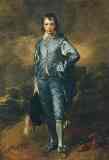Mrs Philip Leslie Agnew
From
a sitter for Sargent describing her experience in 1902 to Evan Charteris
(Sargent's biographer and freind)
Mrs Philip Leslie Agnew
At one of my sittings during which Mr. Sargent painted my hands I sat motionless for two hours. A certain way in which I had unconsciously put my hands together pleased him very much because the posture, he said, wasMusic did indeed permiate Sargent's life. See also Max Beerbohm's caricature:clearly natural for me. He implored me not to move. We worked very hard -- he with his magical brush, I with my determination to control fidgets and the restless instincts to which sitters are prone when sitters are forced to remain still for any length of time, for the most part we were silent. Occasionally I heard him muttering to himself. Once I caught: "Gainsborough would have done it! . . . Gainsborough would have done it!"[1]
He was working at a fever heat, and it was so infectious that I felt my temples throbbing in sympathy with his efforts, the veins swelling in my brow. At one moment I thought I was going to faint with the sense of tension and my fear to spoil the pose which had enthused him.
At the end of two hours he declared that the hands were a failure, and he obliterated them.
"I must try again next time," he said in a melancholy tone. At the next sitting he painted the hands quickly as they now appear a tour de force in the opinion of some, utterly unsuccessful in the eyes of others.
My husband came several times to the sittings. On one occasion Mr. Sargent sent for him specially. He [my husband] rode across the Park to Tite Street.
He found Mr. Sargent in a depressed mood, The opals baffled him. He said he couldn't paint them. They had been a nightmare to him, he declared, throughout the painting of the portrait.
That morning he was certainly in despair . . . . Presently he said to my husband: "Let's play a Fauré duet.[2]" They played, Mr. Sargent thumping out the bass with strong stumpy fingers. At the conclusion Mr. Sargent jumped up briskly, went back to the portrait and with a few quick strokes, dabbed in the opals. He called to my husband to come and look: "I've done the damned thing," he laughed under his breath.
My sister, on the occasion of her visit to the studio during the last sitting, remembers seeing Mr. Sargent paint my scarf with one sweep of his brush.
What appeared to interest him more than anything else when I arrived was to know what music I had brought with me.
To turn from colour to sound evidently refreshed him, and presumably the one art stimulated the other in his brain.
(Letter to Evan Charteris; "John Sargent"; Benjamin Blom, Inc. NY; 1972; pp. 157-158)
(1)
Thomas Gainsborough, English Rococo
Era/Romantic Painter, 1727-1788, specialized in portraits. Probably one
of his most famous paintings is "Blue Boy"

Jonathan Buttell: The Blue
Boy
c 1770
Huntington Gallery
Oil on canvas
70 5/8x
48 3/4 in
(2)
French composer Gabriel Fauré
was a close personal friend to Sargent. T